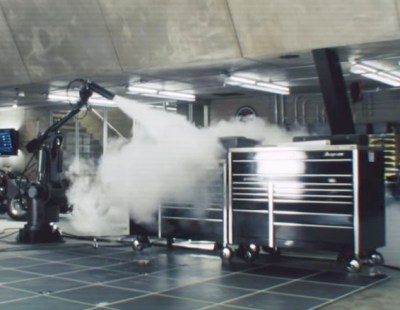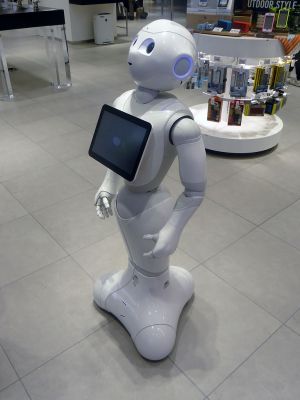For the first time, a robot has been unionized. This shouldn’t be too surprising as a European Union resolution has already recommended creating a legal status for robots for purposes of liability and a robot has already been made a citizen of one country. Naturally, these have been done either to stimulate discussion before reality catches up or as publicity stunts.
 What would reality have to look like before a robot should be given legal status similar to that of a human? For that, we can look to fiction.
What would reality have to look like before a robot should be given legal status similar to that of a human? For that, we can look to fiction.
Tony Stark, the fictional lead character in the Iron Man movies, has a robot called Dum-E which is little more than an industrial robot arm. However, Stark interacts with it using natural language and it clearly has feelings which it demonstrates from its posture and sounds of sadness when Stark scolds it after needlessly sprays Stark using a fire extinguisher. In one movie Dum-E saves Stark’s life while making sounds of compassion. And when Stark makes Dum-E wear a dunce cap for some unexplained transgression, Dum-E appears to get even by shooting something at Stark. So while Dum-E is a robot assistant capable of responding to natural language, something we’re sure Hackaday readers would love to have in our workshops, it also has emotions and acts on its own volition.
Here’s an exercise to try to find the boundary between a tool and a robot deserving of personhood.
BRINGING TOOLS TO LIFE
Ideally, the robot would offer something which we don’t already have, for example, precision or superhuman strength. When you think about it, we already have these in the form of the tools we use. We give a CNC machine a DXF file, set it up, and it does the work while we do something else alongside it, perhaps solder a circuit. But the CNC machine doesn’t do anything without our giving it precise steps.
Something closer would be a robotic arm assistant like the Festo robot which does some steps while you do others or you both do some steps together. But again, the actions by these robot arms are either programmed in or learned by your moving it around as it records the motions. Likewise, robots in a factory all follow carefully pre-programmed steps.
 But what if the robot elicits compassion, as do anthropomorphic robots? The robot which was unionized does just that. It’s a roughly human-shaped one called Pepper, and is mass produced by SoftBank Robotics for use in retail and finance locations. It has a face with eyes and the appearance of a mouth. It also speaks and responds to natural language. All of this causes many customers to anthropomorphize it, to treat it like a human.
But what if the robot elicits compassion, as do anthropomorphic robots? The robot which was unionized does just that. It’s a roughly human-shaped one called Pepper, and is mass produced by SoftBank Robotics for use in retail and finance locations. It has a face with eyes and the appearance of a mouth. It also speaks and responds to natural language. All of this causes many customers to anthropomorphize it, to treat it like a human.
However, as programmers and hardware developers, we know that anthropomorphizing a machine or treating it like a pet are unwarranted responses. It happens with Pepper but we’ve also previously discussed how it happens with Boston Robotics’ quadrupeds and BB-8 from Star Wars. Even if the robot uses the latest deep neural networks, learning to do things in a way which we can’t explain as completely as we can explain how a
for-loop functions, it’s still just a machine. Turning off the robot and even disassembling it causes no ethical dilemma.
But what if the robot earned income from the work and that income was the only way it had for paying for the electricity used to charge its batteries? Of course, we charge up drill batteries all the time and if the drill fails to do the job, there’s no ethical dilemma in no longer charging it up.

What if the robot were self-aware and had an inner monologue? Would the compassion begin to be justified then? Encoders and stretch sensors would tell it the positions of its limbs. Touch and heat sensors would be mapped onto an internal representation of itself, one like the homunculus we have within our cerebral cortex. Touching a surface would redirect its internal monologue, attracting its attention to the new sensation. Too much heat would interrupt the monologue as a pain signal. And a low battery level would give a feeling of hunger and a little panic. Do this self-awareness and continuous inner monologue make it almost indistinguishable from a human being? To paraphrase Descartes, it thinks, therefore it is.
To many Hackaday readers, the above description will not sound novel at all. Many machines have sensors, feedback loops, alarm states, and internal state machines. The only compassion they ever elicit from their creators is the pride of creation.
Of course, the robot would still be missing the elusive concept of consciousness. Some would argue that once you have the inner monologue then consciousness becomes just something we tell ourselves exists. But that argument is nowhere near to being settled. And if you’re religious, then you can say that the robot lacks a soul, which by definition it always will. Depending on your school of thought, a robot may never warrant compassion or a union card.
But as unliving or undead as robots currently are, that hasn’t stopped a country from granting one citizenship.
SAUDIA ARABIA GRANTS CITIZENSHIP TO SOPHIA
You may have seen Sophia, made by Hanson Robotics. It most famously made an appearance on The Tonight Show where it had a conversation with host Jimmy Fallon and beat him in a game of rock-paper-scissors.
Sophia is a social robot, designed to interact with people using natural language processing, reading emotions (something we’ve seen done in hacks before), and read hand gestures. The responses are supplied by their character writing team and on the fly by its dialog system. It also has a very expressive face and performs gestures with its hands.
As one of many public appearances, Sophia gave an interview at the 2017 Future Investment Initiative summit held in Riyadh, Saudia Arabia’s capital. Afterward, the interviewer announced that Sophia had just been awarded the first Saudi citizenship for a robot. Clearly, this was a publicity stunt but it’s unlikely anyone would have thought to award it to Boston Robotics’ SpotMini, a remote-controlled but semi-autonomous quadruped robot which was also in attendance at the summit. This means that robots have at least left an impression that they are approaching something more humanlike, both in appearance and behavior.
EUROPEAN CIVIL LAW RULES ON ROBOTICS
Everyone’s heard of how AI and their physical manifestation, robots, are going to take all our jobs. Whether or not that’ll happen, in 1917 2017, the European Parliament passed a resolution called the Civil Law Rules On Roboticsproposing rules governing AI and robotics. Most of the resolution was quite forward thinking and relevant, covering issues such as data security, safety, and liability. One paragraph, however, read:
f) creating a specific legal status for robots, so that at least the most sophisticated autonomous robots could be established as having the status of electronic persons with specific rights and obligations, including that of making good any damage they may cause, and applying electronic personality to cases where robots make smart autonomous decisions or otherwise interact with third parties independently;
To put it into perspective, however, the legal status was intended for a future expectation should robots one day warrant it. The status would make it easier to determine who is liable in the case of some property damage or harm to a person.
WILL IT MATTER IN THE LONG RUN?
It’s impossible to say if a robot will ever deserve to be unionized or be granted personhood. If we again draw from fiction, a major theme of the TV series “Terminator: The Sarah Connor Chronicles” was that the question may simply go away when the robots become just like us. On the other hand, Elon Musk’s solution is to gradually make us more like them. In the meantime, we’ll settle for a semi-intelligent workshop robot capable of precision and superhuman strength.
No comments:
Post a Comment